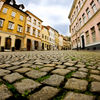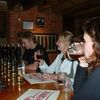Backpacking the Camino de Santiago
Joshua Meindertsma
The Camino de Santiago, or Way of St. James, is a centuries-old pilgrimage route for Christians to the supposed burial of one of Jesus’ 12 apostles, ending in Santiago de Compostela, Spain. The trail has attracted millions of pilgrims-- or peregrinos, as they are called in Spanish-- over the centuries, but you don’t have to be a Christian to take part. The most popular route is the “French way,” beginning in either Saint-Jean-Pied-de-Port in France which crosses the Pyrennes into Spain or Roncesvalles just on the other side across the French border in Spain. I began my route in Roncesvalles by foot, although nowadays the Camino is a popular trail for mountain bikers as well. Before you begin the Camino, you should obtain a Pilgrims passport from one of the starting points or in tourist info centers along the way. This usually costs just a few euros. This identifies you as a pilgrim and you can use it to gain access to refugios or mini-hostels along the route. At these refugios, you will receive a stamp as proof that you have travelled along the course and when you arrive in Santiago de Compostela you’ll receive your certificate of completion, a tradition that dates back to the 14th century. To qualify for the certificate, you need to walk 100km or about 60 miles. If all you want to do is the minimum, I suggest you start in Ponferrada, as it is a large city and you should be able to walk to Santiago de Compostela in a few days, depending on your ability.
The Camino can at times be a leisurely stroll, but if you start in Roncesvalles or beyond the border in France, it’ll be an all-out hike, too. You’ll pass through Pamplona and if you time it right, you can spend a day there during the Festival of San Fermin, otherwise known as the running of the bulls. After each day of walking, you’ll arrive in one of the refugios or hostels along the route. Many of them are run by the state, but in the larger cities you’ll find privately run refugios with nicer amenities at a considerably higher price. During the summer, the lower-cost refugios fill up fast, so if you want to spend a night there, take off earlier in the morning to beat the crowds. Leave early enough to ensure that you walk during the cooler parts of the day, and so that you arrive in the afternoon before many grocery stores and restaurants close for to siesta. Some essentials to pack: a large water bottle or hydration system. The Camino is beautifully fitted with drinkable taps and fountains along the way, including one stop that is sponsored by a local winery where you can fill up on wine before you set out on your trek. But be careful when walking in the mesetas or high desert plains because there you can be without water or access to it for many miles at a time.
A few more essentials to consider. Earplugs: Because you’ll be sleeping in bunk beds, gymnasiums and sometimes barns with horses, these are essential to getting a good night’s sleep so you can be fully rested for the day’s walk ahead. An alarm clock, eye shades and any other sleep aids you may need because refugios can be noisy places. Pack as light as you can with as many fast-drying clothes as you have. I like to bring a frisbee and strike up a game with a new friend, or you can bring a deck of cards. Stay away from ipods and video game devices as the Camino is a full sensory experience that includes getting to know the people you’ll be walking with, the towns you’ll be sleeping in and the rich geographical areas you’ll be traversing. By all means take a camera to remember it all and a journal to write down your day’s adventures.
Some pilgrims you’ll see day in and day out and make the occasional meal with, others you’ll cross paths with and never see again. Just remember, it’s not a race, there are no medals, and when you arrive in Santiago de Compostela, there will be no finish line other than the cathedral itself. Enter it, walk behind the altar of St. James and see for yourself his final resting place. Congratulations, you have kept the Camino alive!
Featured Articles
No-one likes to be cliché but when you're faced with planning a trip to Europe it can be tempting to follow the crowd.
The UK is known for many things: rain, a scandalous royal family, old buildings and bad food all spring to mind.
People often think that travel in Europe is easy; that cultural gaffes aren’t an issue and that the challenges of Africa or Latin America don’t apply.
Every year in August people get together to throw tomatoes at each other. I hate tomatoes, I think they are disgusting, so...
Free Backpacking Europe Planning & Essentials Guide
Download/More info on the Backpacking Planning and Essentials Guide
Featured Articles
No-one likes to be cliché but when you're faced with planning a trip to Europe it can be tempting to follow the crowd.
The UK is known for many things: rain, a scandalous royal family, old buildings and bad food all spring to mind.
People often think that travel in Europe is easy; that cultural gaffes aren’t an issue and that the challenges of Africa or Latin America don’t apply.
Every year in August people get together to throw tomatoes at each other. I hate tomatoes, I think they are disgusting, so...
Free Backpacking Europe Planning & Essentials Guide
Download/More info on the Backpacking Planning and Essentials Guide





